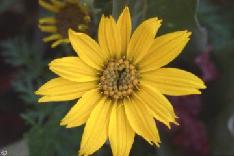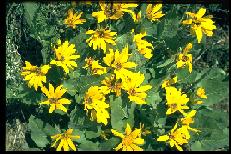
Photo by Barbara & Scott Earl
Sun Valley, Idaho

Photo by Barbara & Scott Earl
Sun Valley, Idaho
Arrowleaf Balsamroot
Balsaorhiza sagittata (Pursh) Nutt.
The most common of the Balsamroots, it is a perennial with a deep-seated, woody taproot. The arrowhead shaped leaves are often 12 inches long, half as wide, and covered with fine woolly primary leaves that are grayish in appearance. The primary leaves appear at the base, although there may be one or two smaller, lance-shaped leaves below the head on the otherwise leafless stalk. It may occasionally produce two heads. It grows on hillsides and flats usually in fairly deep, sandy soil and its range extends form the steppe upward into open Ponderosa Pine forests and Sagebrush dominated mountain ridges often forming a dense population. The first related species of this plant (Buphthalmum sagittatum Pursh.) was reported by M. Lewis on the dry barren hills in the Rocky Mountains. An original specimen collected by Wyeth is at the British Museum. Blooms from the latter part of April to the first part of July.
Food uses: Native Americans would peel and eat raw the tender inner portion of the young immature flower stems. They also ate the large roots and seeds. The roots are tough and woody and taste like balsam. To make them more palatable, the Indians would bake them several days in a fire pit. The strongly pine scented sap, can be converted to a sweet-tasting, easily digest fructose through steaming or roasting the roots for several hours or days. The seeds, after being dried or roasted, can be ground into meal. When mixed with grease and formed into small balls, it was boiled with fat or grease and made into cakes.
Medicine Uses: The Indians used the large coarse Balsamroot leaves as a poultice for burns. The roots were boiled and the solution was applied as a poultice for wounds, cuts and bruises. Indians also drank a tea from the roots for tuberculosis and whooping cough. It has also been used to treat rheumatism, headaches, venereal disease and whooping cough. The sap has anti-bacterial and anti-fungal properties.

Copyright © 1995 Brother Eric Vogel, St. Mary's
College